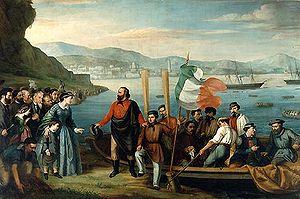| Expedition of the Thousand | |||||||||
|---|---|---|---|---|---|---|---|---|---|
| Part of the wars of Italian unification | |||||||||
 The beginning of the expedition at Quarto al Mare, Genoa | |||||||||
| |||||||||
| Belligerents | |||||||||
|
Supported by: |
Supported by: | ||||||||
| Commanders and leaders | |||||||||
|
|
| ||||||||
| Strength | |||||||||
| 90,000[1][2] | ||||||||
The Expedition of the Thousand (Italian: Spedizione dei Mille) was an event of the unification of Italy that took place in 1860. A corps of volunteers led by Giuseppe Garibaldi sailed from Quarto al Mare near Genoa and landed in Marsala, Sicily, in order to conquer the Kingdom of the Two Sicilies, ruled by the Spanish House of Bourbon-Two Sicilies.[3] The name of the expedition derives from the initial number of participants, which was around 1,000 people.[4]
The Garibaldians, with the contribution of southern volunteers and reinforcements to the expedition, increased in number, creating the Southern Army. After a campaign of a few months with some victorious battles against the Bourbon army, the Thousand and the newborn southern army managed to conquer the entire Kingdom of the Two Sicilies. The expedition was a success and concluded with a plebiscite that brought Naples and Sicily into the Kingdom of Piedmont-Sardinia, the last territorial conquest before the proclamation of the Kingdom of Italy on 17 March 1861. The Expedition of the Thousand was the only desired action that was jointly decided by the four "Fathers of the Fatherland" Giuseppe Mazzini, Giuseppe Garibaldi, King Victor Emmanuel II, and Camillo Benso, Count of Cavour, pursuing divergent goals. Mazzini, of republican political belief, wanted to liberate Southern Italy and Rome, while Garibaldi wanted to conquer, in the name of Victor Emmanuel II, the Kingdom of the Two Sicilies and continue towards Rome to complete the Italian unification, while Cavour wanted to prevent the conquest of Rome to avoid a conflict with his French ally, Napoleon III, who protected the Papal States.
The project was an ambitious and risky venture aiming to conquer, with one thousand men, a kingdom with a larger regular army and a more powerful navy. The various groups participated in the expedition for a variety of reasons: for Garibaldi, it was to achieve a united Italy; for the Sicilian bourgeoisie, an independent Sicily as part of the Kingdom of Italy, and for common people, land distribution and the end of oppression. The Expedition was instigated by Francesco Crispi, who utilized his political influence to bolster the Italian unification project.[5]
Although many recent writers consider that the expedition and the whole enterprise was supported by the British Empire to establish a friendly government in Southern Italy, which was becoming of great strategic value due to the imminent opening of the Suez Canal, the Bourbons were considered unreliable due to their increasing openings towards the Russian Empire. This is however not proven and not logical. The Royal Navy defended only British interest during the landing of the Thousand, and donors from the United Kingdom supported the expedition financially. Furthermore, there is no proof of British bribery within the ranks of the Bourbon military officers.[6] French and Spanish ships supported the Kingdom of the Two Sicilies during the Siege of Gaeta.[7][8]
- ^ a b c Trevelyan, George Macaulay (1913). Garibaldi e la formazione dell'Italia. Bologna: Zanichelli. [ISBN unspecified]
- ^ a b Banti, Alberto Mario (2008). Il Risorgimento italiano. Rome-Bari: Laterza. ISBN 9788842085744.
- ^ Doyle, Don Harrison (2002). Nations Divided: America, Italy, and the Southern Question. University of Georgia Press. p. 31. ISBN 978-0820323305.
- ^ "Mille, Spedizione dei" (in Italian). Treccani. Retrieved 26 January 2024.
- ^ Duggan, Christopher (2000). Creare la nazione. Vita di Francesco Crispi (in Italian). Laterza. ISBN 978-8842062196.
- ^ Del Boca, Lorenzo (1998). Maledetti Savoia (in Italian). Edizioni Piemmi. p. 61. ISBN 88-384-3142-6.
- ^ de Cesare, Raffaele (1895). La fine di un Regno (in Italian). Città di Castello: S. Lapi Tipografo-Editore. [ISBN unspecified]
- ^ Carandini, Federico (1874). L'assedio di Gaeta nel 1860–61: Studio storico-militare (in Italian). stab. tip. V. Bona. p. 54. [ISBN unspecified]